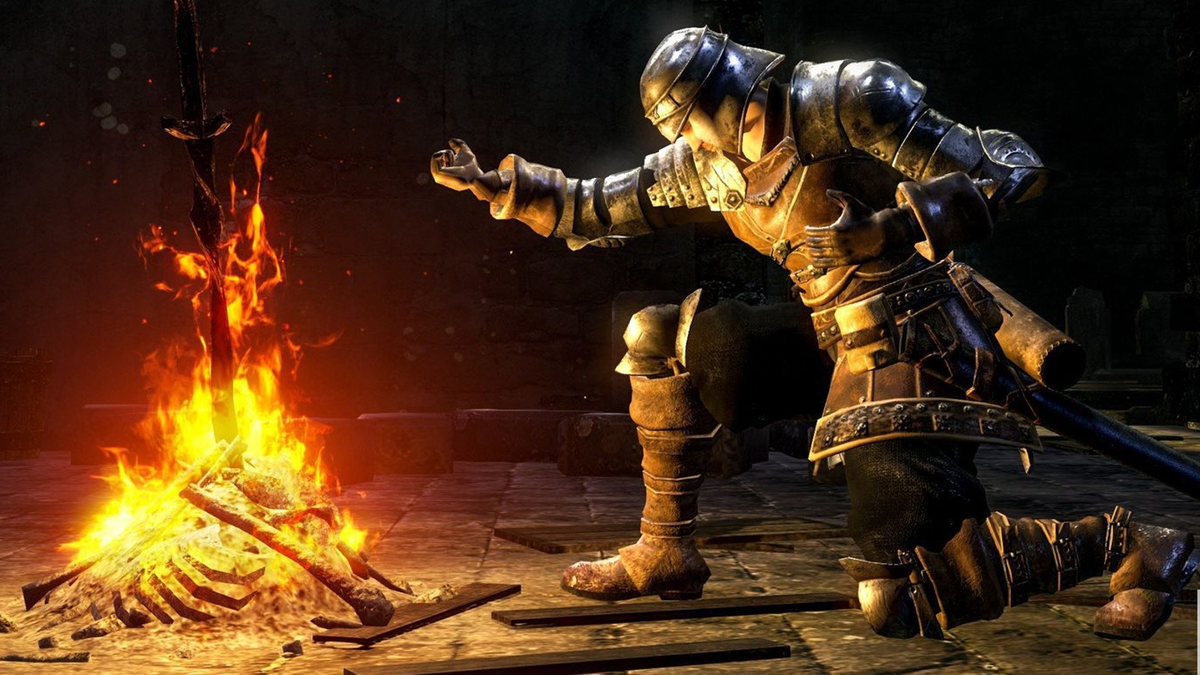
Year three, at least, and I continue to play Dark Souls very, very slowly. Actually, that’s not true. Sometimes I play in frantic bursts. At others I let it lie for months and months with no progress at all. I’m still relatively early on, deep in a dungeon that looks like the inside of someone’s ear, about to fight a spidery boss. In Souls terms, I’m nowhere, a total novice. Yet I never would have gotten this far if it wasn’t for bonfires.
Bonfires in Dark Souls are fascinating. In a game filled with incredibly good ideas, they may be my favourite incredibly good idea. They’re actually at the heart of everything I love: I love the fact that in these games you move a little lens of available health around an incredibly deadly environment, always feeling like you’re making progress, but simultaneously feeling like you’re over-extending yourself. It’s why progress feels so illicit: I got this far, but I’m sure I’m about to die in amongst all the new things I’m seeing. Bonfires are at the heart of that system, because they provide the base you return to, they provide the network of bases, like handholds on the game’s rugged cliff face.
I love the way the environment interlocks, too: the way you’ll head off upwards or downwards, see some incredible stuff, and feel thoroughly lost. But you trust the game and you know that if you keep going far enough, if you follow a trail with sufficient patience, it will inevitably oxbow in some fascinating way and bring you back to where you started, but facing in the other direction. Magic! Absolutely magic, if you ask me, and guess what: bonfires are at the heart of all that too. In a game of loops and snarls and dangerous tangles, they provide clear junction points, a moment to rest and say: ah, I’m here. I’m somewhere.
Bonfires famously do a lot of stuff that it took me a while, raised on other games, to get my head around. They reset the world and all the monsters in it? Whatever for? But I get that now, too. Or at least I get why it works for me. A bonfire is a rest – it’s a chance to ease up for a bit, to take stock. I would absolutely abuse that ability if there wasn’t skin in the game. I love bonfires a little bit because there is so much to hate about them. They take all the work I’d done, pluck it out of my “out” tray, and shove it back into my “in” tray. I appreciate this is a rather elderly analogy. Back in the day when offices used paper, we used to have these trays, see…
Over the last few days, though, as I’ve been alternating between Dark Souls and Elden Ring, which I have also been playing slowly, stop-start, for an age and without making much progress, I’ve realised something else about bonfires too. It’s a bit cosmic, so apologies in advance.
One of the things that fascinates me about these games is how much the audience invests in them and invests in their worlds as real, tangible places. People get tangled in the lore and fascinated by the landscape and its history. And I am starting to think the bonfires encourage that. Bonfires, sites of grace, whatever you want to call them: they’re still a moment to sit and rest and take stock. They’re still bonfires, a part of the world that isn’t yours, but can be yours for a spell.
And that’s it, I think. FromSoftware’s world-building is brilliant, best-in-class perhaps, but they have this extra trick. They let you sit there, camp there, own a view or a vista or even a dark basement in the Burg. When you come back to the game you know you’ll be at a bonfire. When you leave the game, you’ll often be leaving it at a bonfire. The imagination of the player – this player at least – is susceptible to these cues. Horrible, dangerous, beautiful world. But there’s a place for me in it, where I can stay as long as I want, where nothing bad will happen, and where I can simply be in this world.
